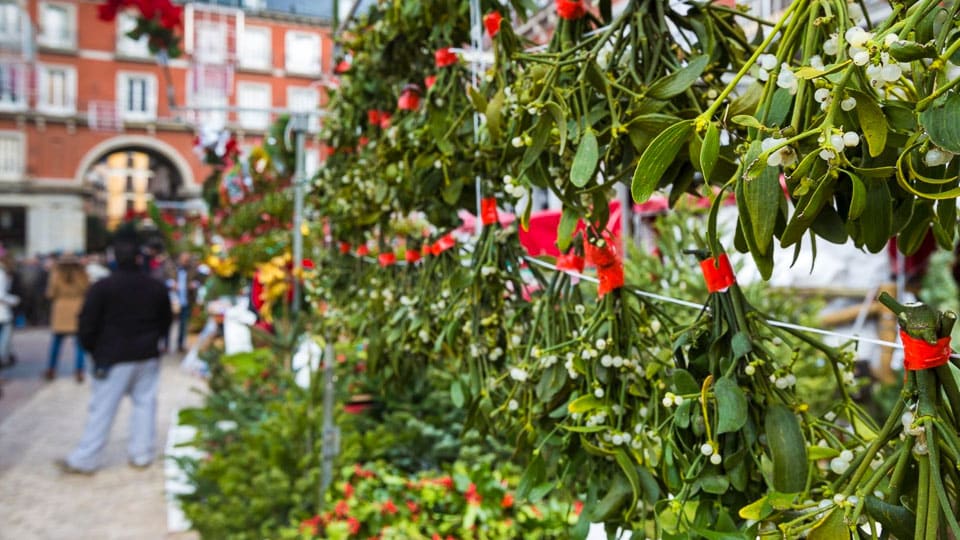
Note: this post, originally published in 2020, was updated in December 2023.
We’ve spent several Christmas seasons in Spain, none better than the year we traveled with our children to Madrid and Seville. That's when we discovered Spain’s Christmas markets, seasonal cakes, sparkling cava, and the January processions of the Reyes Magos, the Three Kings celebrated on the Epiphany, January 6th.
Next time you think of spending Christmas and New Year’s Eve abroad, remember Spain. Its markets are every bit as good as the more highly touted northern European variety and, we dare say, the fun factor is unbeatable. Given its strong Catholic traditions – more than 90 percent of Spaniards are baptized Catholic – Spain keeps the meaning of Christmas vital while infusing it with popular culture.
Some posts on Travel Past 50 may contain affiliate links. If you buy something through one of those links, we may earn a small commission. As an Amazon associate, we earn from qualifying purchases.
Each distinct region of Spain celebrates Christmas with a local twist. But throughout Spain, special holiday traditions really shine in Christmas markets, in seasonal foods, unique gifts, and lively festivals. No matter what part of the country you travel, Christmas in Spain will sprinkle your holidays with joy. Read on for details about the Christmas season in Spain, and refer to Spain's excellent tourism website for articles about regions, events, and suggested itineraries.
Table of Contents
How the Spanish Celebrate the Holidays
In Spain, as elsewhere, the holiday season is a special time for Spanish families to gather and for friends to celebrate. More so than in the U.S., the holidays are punctuated by several special dates through December and into January.
Christmas celebrations may start as early as the end of November when Christmas trees and Christmas lights are displayed around towns and squares. Markets usually open by December 1, and the anticipation is palpable. For adults the markets are a meeting point and social event where shoppers pause for sweets or drinks.
The holidays really kick off on December 8, the Feast of the Immaculate Conception. Banks and offices are closed and families often gather on this holy day. Until the 1960s, December 8 was a celebration of Mother's Day, too, though that's been changed to May. You can expect that homes will be decorated for Christmas by about this date, with lights, a tree, or a Tió de Nadal (see below).
The main Christmas meal might be a family dinner held at a restaurant on Christmas Eve or at home on Christmas Day. Expect an array of appetizers, charcuterie, perhaps a tasty seafood soup, followed by a main course of fish, lamb, or suckling pig. Dessert platters overflow with options from pastries, cookies, chocolates, etc.
Christmas mass, also referred to as la misa del gallo (Rooster’s Mass), is a midnight mass on December 25 (late Christmas Eve). Most families also visit their parish earlier in the month specifically to view the nativity scene on display, and perhaps hear a concert.
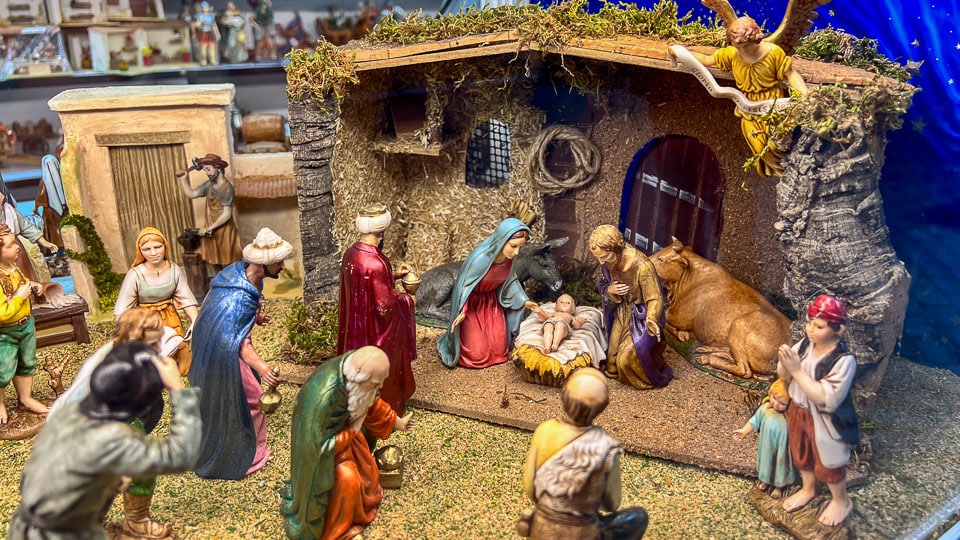
Between Christmas and the new year is the Dia de los Santos Inocentes (Day of the Holy Innocents), December 28. It's become similar to April Fools' Day: a day of practical jokes and mischief. Then New Year’s Eve comes with its unique Spanish celebrations. Read on!
Finally, the day all Spanish children look forward to. Three Kings Day on January 6 celebrates the Epiphany, when the three wise men first saw Baby Jesus and presented gifts. Parades or floats bearing three kings pass through city streets, candy is tossed to children, and gifts are exchanged on this day.
Santa Claus was not traditionally part of Spain’s traditions, in favor of gift exchanges on January 6. But Father Christmas has entered the scene for many Christmas Day celebrations.
Best Christmas Markets in Spain
Our experience with Christmas markets in Spain began in Madrid’s Plaza Mayor. This huge outdoor market, filling the public square, represents one of our favorite things about Spain: the seamless combination of passionate observance of solemn traditions with the festive party atmosphere enjoyed by all generations–by families, friends, and close communities.
Madrid Christmas Markets
In big and small towns, the Spanish Christmas markets feature vendors selling nativity figurines of all sorts, from the Holy Family to barnyard animals to crazy village characters (see below). In Plaza Mayor, we wove through stalls selling Christmas stockings and décor, gifts, clothing accessories, toys, and, yes, candy and food to keep the crowd happy. Best of all was the people watching. Mothers and children veer off in separate directions, distracted by music, colors, lights, toys, and candy, lots of candy. We found all sorts of fun stocking stuffers to buy before our appetites, whetted by the combined smells of roasted chestnuts and sugary treats, forced us to stop for food.
Plaza Mayor, of course, is lined with restaurants and bars, so it’s simple to ease in and out of the market action to load up on food and beverages of your choice.
Sevilla Christmas Markets
The city of Sevilla lights up for Christmas and features high quality markets in various locations. Plaza Nueva, about a 10-minute walk from the cathedral through the shopping district, has been market central for years. The streets around the Cathedral showcase wonderful craft items for creating your own nativity scenes at home. And for a special week in December, boxes of sweets from the city's convents are sold outside the Real Alcázar.
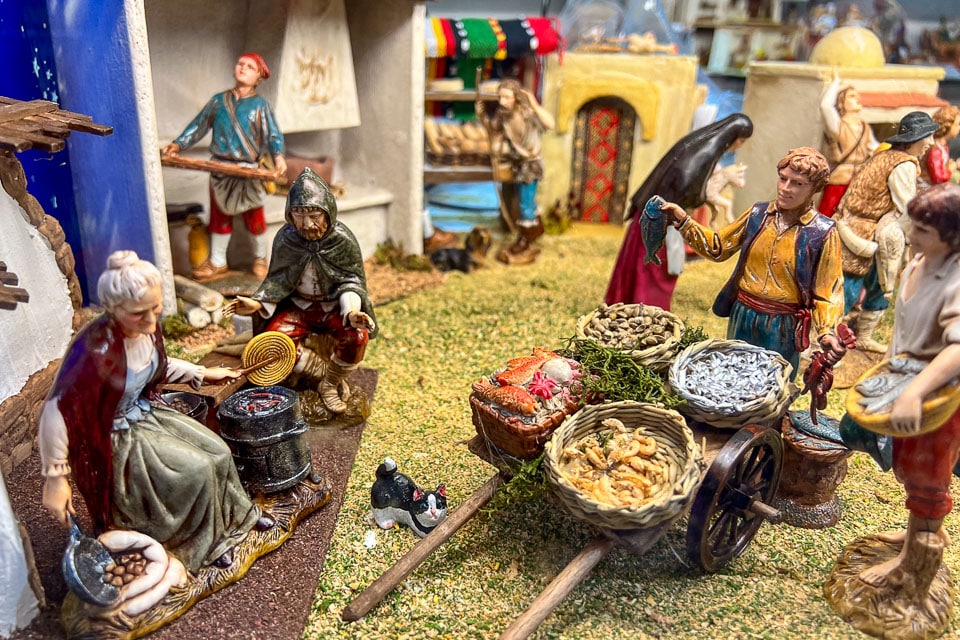
Barcelona Christmas Market
Barcelona's market in front of the Cathedral is known for its array of Christmas decorations and for musical instruments and performances.
Belén: Nativity Scenes
Perhaps right in the midst of a Spanish Christmas Market, or nearby in another plaza, or inside most churches, not to mention in almost every home, Christmas nativity scenes are a huge part of Spain’s Christmas celebrations. Called a Belén, the Spanish name for Bethlehem, the simplest nativity scenes include figures of Joseph, Virgin Mary and Baby Jesus, surrounded by animals, shepherds, and the three Wise Men. Many elaborate Belenes, however, depict entire villages populated by busy people, with architectural and cultural detail befitting a museum.
Some towns, like Cádiz, sponsor a living Belén. Check with local tourism offices for annual updates and suggested routes for viewing all sorts of nativity displays, indoors and out. Madrid's office reports on dozens in the area, including the live nativity in El Escorial.
Public squares and churches usually utilize life-size figurines. In private homes, the nativities are personalized and miniaturized.
Don’t be put off by the queues forming to view the cities’ best nativity scenes, usually protected in churches or civic squares. Happy holiday shoppers munch candies as they line up to visit the best belenes in town. It’s a great chance to overhear the chatter and get in the spirit of the season.
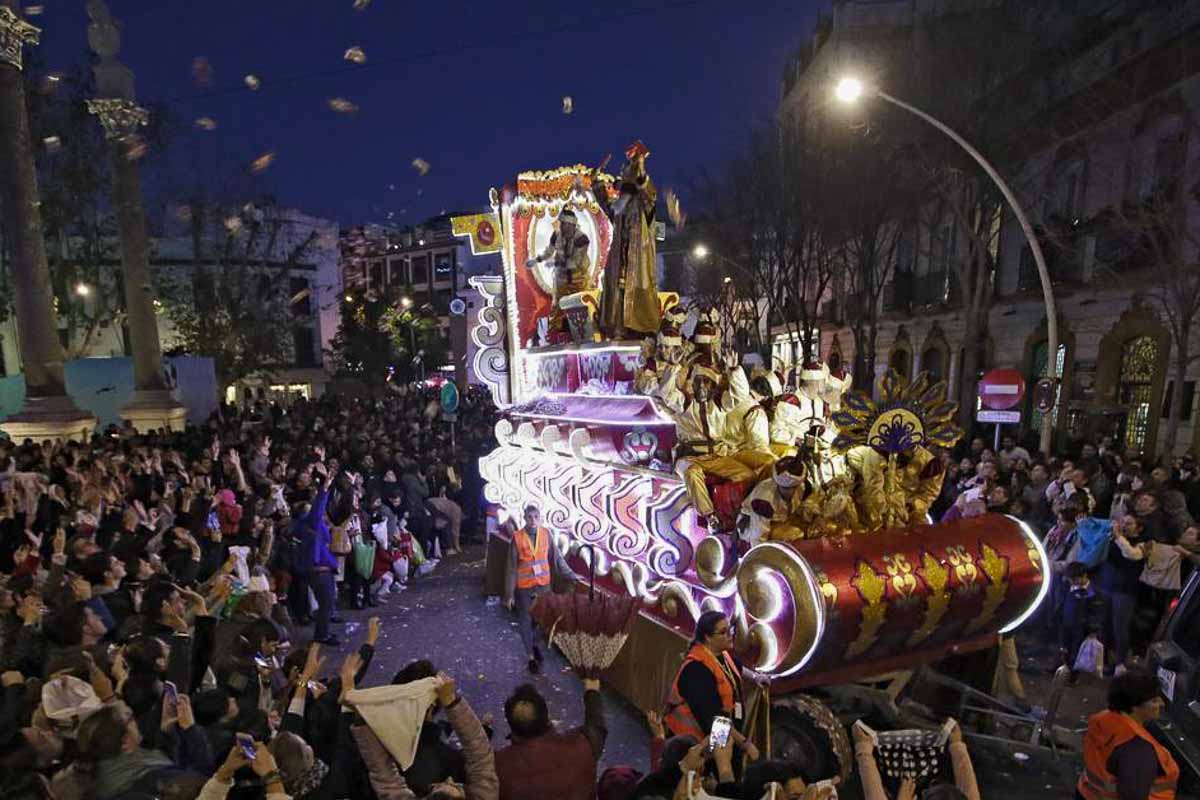
Three Kings Day
In Spain (and a few Latin American countries), Epiphany, or Three Kings Day, or Day of the Magi (Reyes Magos) is really the heart of the season’s celebration. January 6, or the twelfth day of Christmas, marks the arrival of the three kings bearing gifts for the infant child, the Dia de los Reyes Magos festivities are all about gifts–and more candy!–for children. We were lucky to find ourselves in Sevilla to experience this unique holiday.
The typical celebration starts with a procession on the evening of January 5, comprised of the three kings entering the town and tossing candy to the excited children lining the street. The Kings ride in on camels or brightly decorated floats, and are surrounded by dancers, music, and glittery decorations. The historic Three Kings Parade in Alcoy, Alicante, involves letters posted to the Three Wise Men by children, and gifts delivered up ladders to the balconies of apartments above.
It’s a beautiful night of lights and good cheer. The following day, like Christmas Day, is generally devoted to big family dinners and more gifts.
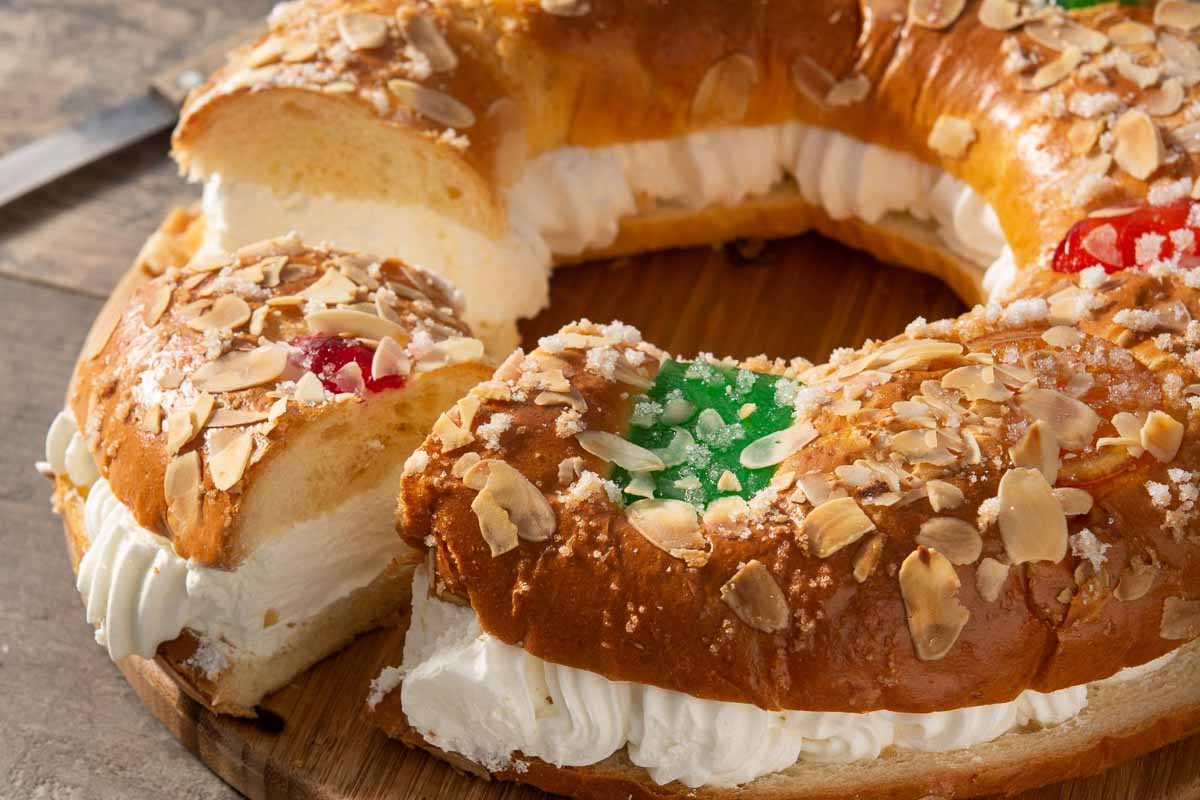
Christmas Food and Drink in Spain
Around Spain, as around the world, Christmas celebrations are filled with food. Not surprising, the centerpiece is the roscón cake, devoted to Dia de los Reyes. It is not unlike King Cake in New Orleans, and dates back centuries. These days, the roscón de reyes cake is usually filled with whipped cream or flavored cream, and topped with candied fruit or nuts and sugar. The person who finds a small toy king in his or her slice wears the accompanying paper crown for the day.
Christmas treats might also include gold-wrapped turrón (almond flour candies) or polvorones, small powdered-sugar shortbread cookies, best eaten carefully lest you wear a sugary bib down your front.
In Spain, the lovely sparkling Cava wine isn’t just reserved for the New Year and Christmas season, but is certainly given center stage at the holiday. Bring it on. Friexenet is a brand commonly found in the U.S. Our favorite Spanish cava is by Juvé y Camps. (Both are from the Catalonia region.)
Family meals on Christmas Day and El Dia de los Reyes will likely feature the respective region’s most typical dish. For our part, we favor a roast leg of lamb on Christmas with a nice arroz con leche or flan dessert.
When grocery shopping for your holiday meals and entertaining, be sure to stock up on grapes. Practicing Spain’s New Year’s Eve tradition of eating one grape upon each of the twelve strokes of midnight will bring you good luck in the new year.
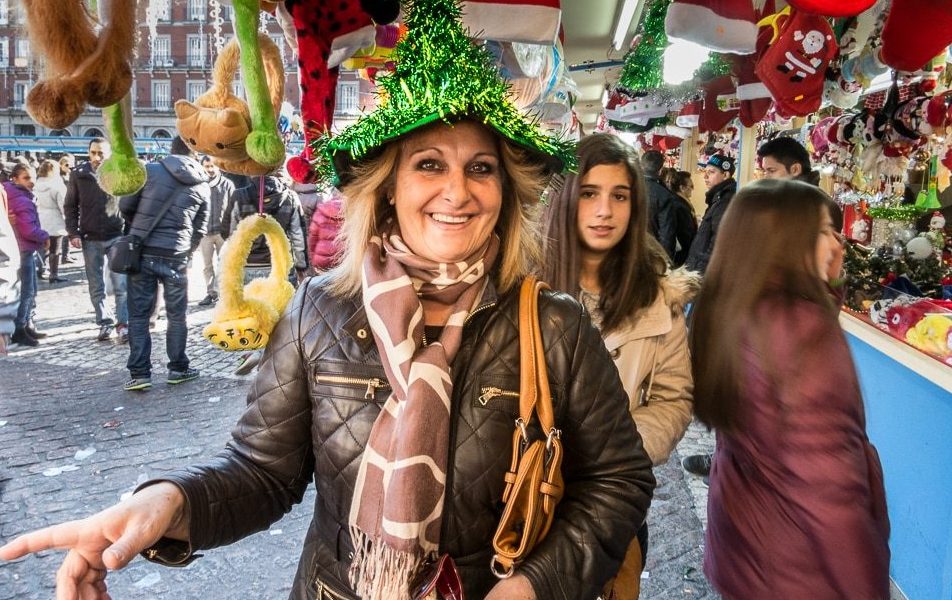
Spain’s Unique Christmas Traditions and Gifts
El Gordo
Let’s not forget another secular tradition of the season, the Spanish Christmas lottery, If you are lucky enough to spend the Christmas season in Spain, you might be lucky enough to draw the winning numbers and big money. (Yes, foreigners and non-residents can win, and yes, winnings are taxable.) This season lottery is one of the year's big ones. El Gordo means, literally, the fat one. Join in the fun…and suerte (good luck).
Caganers
Originating in Catalonia, and now common across Spain, are surprising nativity interlopers, the caganers or ‘crappers' and their variation the pooping log. These humorous stooping, defecating figures are said to symbolize fertilization and prosperity for the new year. Or maybe that’s just rationalization for a little fun. In Catalunya, the traditional caganer is a red-capped independence figure. But in recent decades, the popular items depict world-renowned politicians and celebrities–even the Pope–and have become collectibles. Find all varieties at the Christmas markets.
Caga Tió, Tió de Nadal
You may see in some homes around Spain a variation of the Caganer called the Tió de Nadal (Christmas Log) or Caga Tió (Defecating Uncle). Early in December, a log is brought into the home, generally set on a stand or legs, draped with a warming red cape, perhaps given a face, and nurtured daily by the children. The log is akin to a Christmas stocking hanging from the fireplace. When Christmas comes around and after children are sent to another room for a few minutes' preparation, the kids re-enter, smack the log with sticks, and – magically – little gifts and candy appear under the red cape.

New Year’s Eve
Ah, New Year's Eve, the annual ritual of hope for good things to come. In Spain, we love the tradition of eating twelve lucky grapes to assure good things for the coming year. It's tricky: eat one grape for each chime of the midnight bells. OK, so seedless grapes advised!
If you love to share your New Year's Eve with others, there's no better place that Madrid's Puerta del Sol. But you will find celebrations in almost any city, or be able to view the festivities on TV from the comfort of your living room.
Feliz Navidad y Feliz Año Nuevo!
Spain at Home
When we’re home for the holidays, we love incorporating the little barnyard animals we found at the Christmas Market in Madrid into our tiny mantle nativity scenes. The Christmas decorations at our house combine Spanish, Mexican, Swedish, German characters. If we expect enough people, we might serve food from all those countries, too, with a leg of jamón serrano on the counter, ready to carve and serve.
Find a recipe for “Kings Cake” from our friends at Spanish Sabores. You'll find other Christmas dessert recipes on the site, too, so go ahead and bookmark the page! For great food tours in Spain, like this Madrid food tour we loved, or others throughout Spain, visit Devour Tours in Madrid. More info on Spain's holiday delights can be found on the Devour blog.
For more excellent information on Spain in general and Spain's Christmas traditions specifically, visit Sunshine and Siestas.
May you find yourself in Spain in the new year. Start planning now, and learn more about the quirky Day of the Holy Innocents and Spain's Christmas culinary highlights on the official Spain Tourism website.

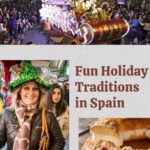
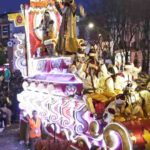
Loved reading this because of the parallels with the Philippine traditions and the common words, my homeland having been ruled by Spain for more than 300 years: Belen, Tres Magos, and eating round fruits at the stroke of midnight of Dec. 31 and suerte!
I have to say that we are a little torn between the nativities and the Christmas food traditions in Spain. It appears that they embrace the spirit of Christmas each year and even have joyous Three Kings parade.
I’ve only ever been to Spain in spring or summer. Looks like there are a lot of fun things to do at Christmastime!